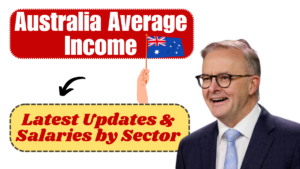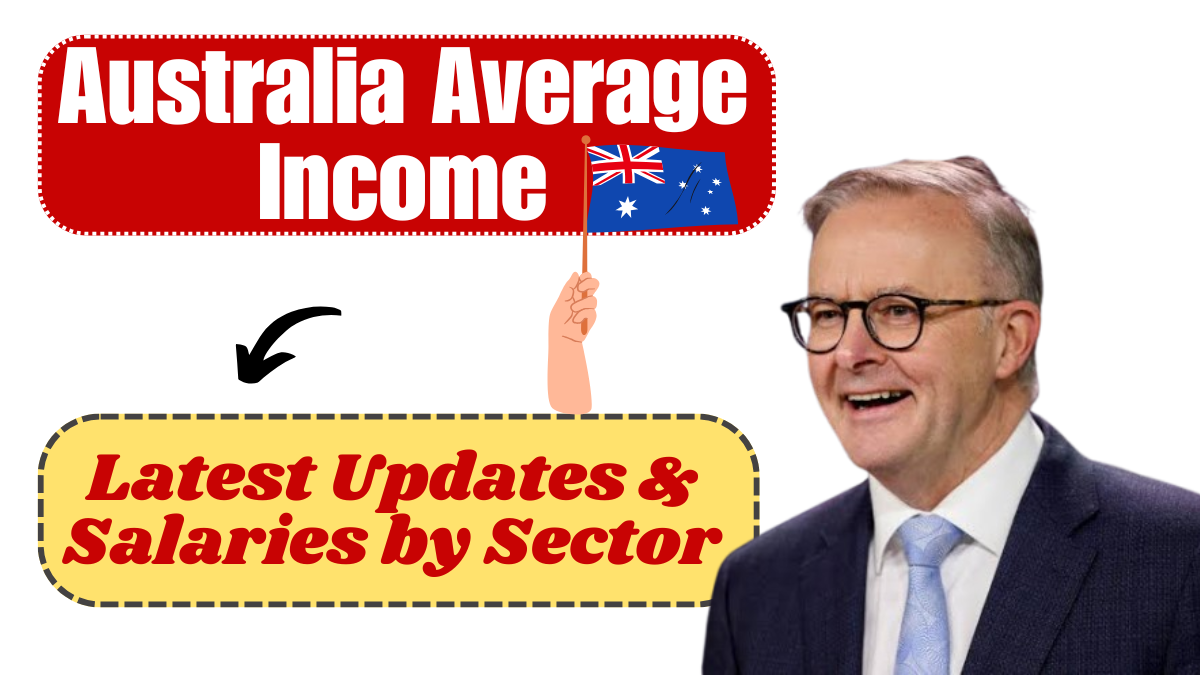Australia remains one of the top destinations for professionals worldwide thanks to its competitive job market, robust healthcare system, and strong education infrastructure. In 2025, average incomes in Australia have shown a steady increase, largely driven by inflation adjustments, rising cost of living, and industry demands.
According to the Australian Bureau of Statistics (ABS), the average annual income for a full-time worker in Australia has reached AUD 89,122.

What Is the Average Salary in Australia in 2025
The average income represents the mean salary, meaning half the workforce earns more and the other half earns less. In 2025, here is how the numbers look:
| Category | Amount (AUD) |
|---|---|
| Annual Average Salary | 89,122 |
| Monthly Average Income | 7,427 |
| Weekly Average Income | 1,713 |
| Hourly Wage Estimate | 43.06 |
These figures can vary significantly depending on one’s industry, role, region, and experience.
Typical Income Ranges Across Australia
The majority of Australians earn within a wide range, but here’s a general breakdown:
- Lower Income Tier: AUD 37,000 – AUD 60,000
- Middle Income Tier: AUD 60,000 – AUD 94,000
- High Income Tier: AUD 95,000 and above
These figures are full-time averages and do not represent part-time or freelance earnings.
Factors That Influence the Average Income in Australia
Understanding what impacts income trends can help job seekers, employees, and employers make better decisions. Here are key influencing factors:
- Industry and Sector: Sectors like IT, engineering, and finance offer higher salaries compared to retail and hospitality.
- Location: Workers in cities such as Sydney and Melbourne typically earn more due to higher living costs.
- Education and Skills: Advanced degrees and high-demand skills lead to better pay.
- Experience: Employees with several years in their field are more likely to earn higher than entry-level workers.
- Government Policies: Changes in tax laws and labour policies also affect earnings across sectors.
- Economic Climate: Recessions, inflation spikes, and employment trends all shift the wage landscape.
Gender Pay Gap in Australia 2025
The gender pay gap continues to be a notable factor in Australia’s income structure. According to a report by the Workplace Gender Equality Agency (WGEA), the national gender pay gap in 2025 is approximately 14.2%.
This gap is calculated based on average weekly earnings for full-time workers. Factors contributing to the gap include:
- Career interruptions (often due to maternity or caregiving)
- Fewer women in high-level executive roles
- Lower representation in high-paying industries
- Part-time and casual job patterns among women
Efforts are ongoing to address these inequalities through both policy changes and public awareness campaigns.
MUST READ: Pension Boost Canada: Expected CPP and OAS Pension Increase in March 2025
Australia’s Minimum Wage in 2025
Along with average incomes, minimum wage plays a critical role in shaping national compensation trends.
| Minimum Wage Category | Amount (AUD) |
|---|---|
| Hourly Minimum Wage | 20.33 |
| Weekly Minimum Wage (38 hrs) | 772.60 |
| Monthly Estimate (Full-time) | 3,037 |
These rates are set annually by the Fair Work Commission and are adjusted based on inflation, employment trends, and living costs.
Why Australia’s Income Landscape Matters in 2025
Australia’s income growth, driven by strong economic performance and labour market resilience, helps sustain a high quality of life. Higher wages also support improved housing access, better education, and healthcare affordability.
While economic conditions like inflation continue to shape wage expectations, Australia remains among the world’s most stable and lucrative places to work in 2025.
FAQs
What is the average salary in Australia in 2025?
As of 2025, the average annual salary for a full-time Australian worker is approximately AUD 89,122, or AUD 7,427 per month.
Which industries pay the most in Australia?
The top-paying sectors include technology, engineering, finance, healthcare, and mining. These sectors often offer above-average salaries due to specialized skills and demand.
Is the gender pay gap still an issue in Australia?
Yes. The national gender pay gap remains around 14.2% in 2025, mainly due to part-time work, caregiving responsibilities, and underrepresentation in senior roles.
How much is the minimum wage in Australia?
In 2025, the minimum hourly wage is AUD 20.33, which translates to AUD 772.60 per week for a standard 38-hour workweek.
Do salaries differ by region?
Yes. Urban centers like Sydney, Melbourne, and Brisbane offer higher wages compared to rural and regional areas, primarily due to the cost of living and job concentration.
What factors determine how much I get paid?
Your pay depends on education, experience, industry, job location, skill set, and employer policies. Economic conditions also influence wage growth.
Is the average income enough to live comfortably in Australia?
While average incomes cover basic living expenses in most areas, those living in major cities may face financial pressure due to higher housing and utility costs.
How often is minimum wage reviewed?
Australia’s minimum wage is reviewed annually by the Fair Work Commission to ensure it reflects changes in living costs and inflation.
Click here to know more.
Aanchal is a passionate writer with a keen interest in storytelling, content creation, and creative expression. She enjoys exploring diverse topics and crafting engaging narratives that captivate readers.

